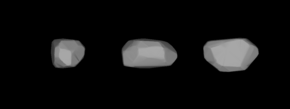695 Bella
 A three-dimensional model of 695 Bella based on its light curve | |
| Discovery | |
|---|---|
| Discovered by | Joel Hastings Metcalf |
| Discovery site | Taunton, Massachusetts |
| Discovery date | 7 November 1909 |
| Designations | |
| (695) Bella | |
| 1909 JB | |
| Orbital characteristics[1] | |
| Epoch 31 July 2016 (JD 2457600.5) | |
| Uncertainty parameter 0 | |
| Observation arc | 102.48 yr (37432 d) |
| Aphelion | 2.9457 AU (440.67 Gm) |
| Perihelion | 2.1375 AU (319.77 Gm) |
| 2.5416 AU (380.22 Gm) | |
| Eccentricity | 0.15900 |
| 4.05 yr (1480.0 d) | |
| 183.825° | |
| 0° 14m 35.7s / day | |
| Inclination | 13.838° |
| 275.632° | |
| 79.589° | |
| Physical characteristics | |
Mean radius | 24.09±0.75 km |
| 14.222 h (0.5926 d) | |
| 0.1450±0.009 | |
| 9.30 | |
695 Bella is a minor planet orbiting the Sun.
Although this asteroid has dynamic properties that make it a candidate for the Maria family, the spectral properties of the object indicate it is most likely an interloper. Instead, it may have been spalled off from 6 Hebe or its parent body. 695 Bella and 6 Hebe orbit on opposite sides of the 3:1 Kirkwood gap, and the two have similar orbital elements.[2]
References
- ^ "695 Bella (1909 JB)". JPL Small-Body Database. NASA/Jet Propulsion Laboratory. Retrieved 5 May 2016.
- ^ Fieber-Beyer, Sherry K.; et al. (June 2011), "The Maria asteroid family: Genetic relationships and a plausible source of mesosiderites near the 3:1 Kirkwood Gap", Icarus, 213 (2): 524–537, Bibcode:2011Icar..213..524F, doi:10.1016/j.icarus.2011.03.009, retrieved 23 December 2015.
External links
- 695 Bella at AstDyS-2, Asteroids—Dynamic Site
- 695 Bella at the JPL Small-Body Database
